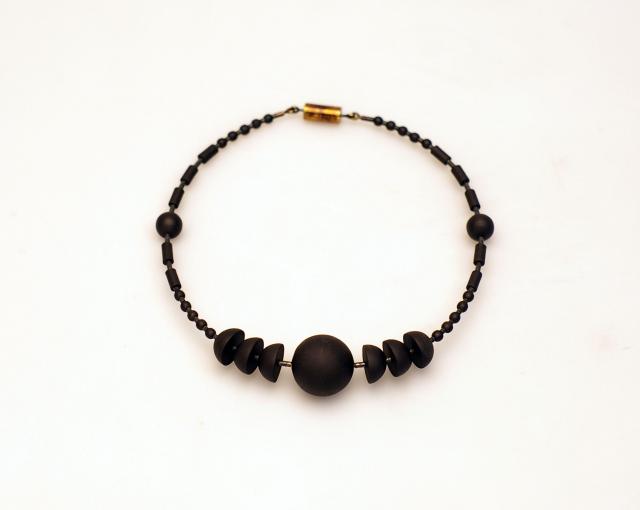Wedgwood and Jewellery: Black Basalt Necklace
This necklace was made in 1982 by the English jewellery artist Wendy Ramshaw in collaboration with Wedgwood. The beads are made of lathe-turned black basalt to create forms of spheres, hemispheres and cylinders, threaded onto silver with a drum-shaped silver fastener hallmarked WR.
Lathe turning was part of the finishing process where the clay is dried until it is leather-hard and then, as the piece is turned on the lathe, the surface is shaped by removing clay with special tools. This technique was used for Wedgwood’s vases giving them their refined silhouettes.
Wendy Ramshaw was born in 1939 in Sunderland and trained as an illustrator and industrial designer, and as an art teacher. At the beginning of her career she earned a living lecturing and teaching, drawing, illustrating, and designing and printing fabrics. Making jewellery had always been a side line, its fascination originated from early childhood when she used to make trinkets out of scraps of fabric.
Ramshaw’s first jewellery developed out of exercises for copper engraving and, in 1964, she made her first steps towards commercial jewellery in launching her first pieces of Optic Art, together with her husband David Watkins. Only three years later she would develop the first example of a multiple ring set - the type of jewellery she became best known for.
Several exhibitions and awards were to follow and, in 1978, she started to include ceramics in her work which were mainly modelled by the artist herself. With this development the metal used in her jewellery became less and less prominent. As she already contributed to a series of small loan exhibitions of work by artist-jewellers in the Jewellery collection of the V&A, she seized the chance when she was asked to take part in a second series allowing her to develop her use of ceramics. She approached Wedgwood to collaborate and the company immediately agreed. Results of this partnership included one-off pieces, as well as multiples, and Wendy Ramshaw especially appreciated the opportunity to work with ceramic bodies such as black basalt, as she later said, “The collaboration with Wedgwood, a generous form of patronage, afforded the chance of using the famous black basalt so highly regarded by the first Josiah Wedgwood. This clay was reputed to have the most excellent turning properties, so I began the collaboration with optimism.”
With its edgy, clean and simple shapes and sober colouring, this necklace mirrors perfectly the taste of the time but still combines material and craftsmanship that was appreciated back in the 18th century. This was underlined through the necklace’s manufacture which used a replica of a lathe Josiah Wedgwood installed in his works in the 18th century.
“I frequently refer to my use of the lathe as not unlike the potter’s use of the wheel. The way in which thinking and feeling suggest a series of shapes seems to be similar. The lathe is a liberating tool enabling me to work with greater speed and accuracy and allowing me to spend more time developing ideas.” Wendy Ramshaw.
